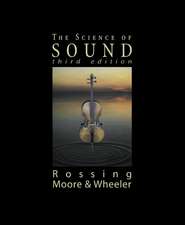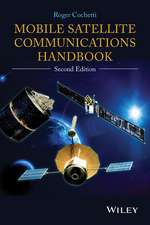Automatic Modulation Recognition of Communication Signals
Autor Elsayed Azzouz, A.K. Nandien Limba Engleză Hardback – 29 noi 1996
Drawing on several years of research, the authors provide a critical review of automatic modulation recognition. This includes techniques for recognising digitally modulated signals. The book also gives comprehensive treatment of using artificial neural networks for recognising modulation types.
Automatic Modulation Recognition of Communications Signals is the first comprehensive book on automatic modulation recognition. It is essential reading for researchers and practising engineers in the field. It is also a valuable text for an advanced course on the subject.
| Toate formatele și edițiile | Preț | Express |
|---|---|---|
| Paperback (1) | 1213.97 lei 43-57 zile | |
| Springer Us – 30 noi 2010 | 1213.97 lei 43-57 zile | |
| Hardback (1) | 1218.83 lei 43-57 zile | |
| Springer Us – 29 noi 1996 | 1218.83 lei 43-57 zile |
Preț: 1218.83 lei
Preț vechi: 1486.38 lei
-18% Nou
Puncte Express: 1828
Preț estimativ în valută:
233.22€ • 244.16$ • 192.98£
233.22€ • 244.16$ • 192.98£
Carte tipărită la comandă
Livrare economică 07-21 aprilie
Preluare comenzi: 021 569.72.76
Specificații
ISBN-13: 9780792397960
ISBN-10: 0792397967
Pagini: 218
Ilustrații: XVIII, 218 p.
Dimensiuni: 156 x 234 x 19 mm
Greutate: 0.48 kg
Ediția:1996
Editura: Springer Us
Colecția Springer
Locul publicării:New York, NY, United States
ISBN-10: 0792397967
Pagini: 218
Ilustrații: XVIII, 218 p.
Dimensiuni: 156 x 234 x 19 mm
Greutate: 0.48 kg
Ediția:1996
Editura: Springer Us
Colecția Springer
Locul publicării:New York, NY, United States
Public țintă
ResearchDescriere
Automatic modulation recognition is a rapidly evolving area of signal analysis. In recent years, interest from the academic and military research institutes has focused around the research and development of modulation recognition algorithms. Any communication intelligence (COMINT) system comprises three main blocks: receiver front-end, modulation recogniser and output stage. Considerable work has been done in the area of receiver front-ends. The work at the output stage is concerned with information extraction, recording and exploitation and begins with signal demodulation, that requires accurate knowledge about the signal modulation type. There are, however, two main reasons for knowing the current modulation type of a signal; to preserve the signal information content and to decide upon the suitable counter action, such as jamming. Automatic Modulation Recognition of Communications Signals describes in depth this modulation recognition process.
Drawing on several years of research, the authors provide a critical review of automatic modulation recognition. This includes techniques for recognising digitally modulated signals. The book also gives comprehensive treatment of using artificial neural networks for recognising modulation types.
Automatic Modulation Recognition of Communications Signals is the first comprehensive book on automatic modulation recognition. It is essential reading for researchers and practising engineers in the field. It is also a valuable text for an advanced course on the subject.
Drawing on several years of research, the authors provide a critical review of automatic modulation recognition. This includes techniques for recognising digitally modulated signals. The book also gives comprehensive treatment of using artificial neural networks for recognising modulation types.
Automatic Modulation Recognition of Communications Signals is the first comprehensive book on automatic modulation recognition. It is essential reading for researchers and practising engineers in the field. It is also a valuable text for an advanced course on the subject.
Cuprins
1. Introduction. 2. Recognition of Analogue Modulations. 3. Recognition of Digital Modulations. 4. Recognition of Analogue & Digital Modulations. 5. Modulation Recognition Using Artificial Neural Networks. 6. Summary and Suggestions for Future Directions. Bibliography. A. Numerical Problems Associated with the Evaluation of the Instantaneous Amplitude, Phase and Frequency. B. Carrier Frequency Estimation. C. Alternative Algorithms for Modulation Recognition. Index.















